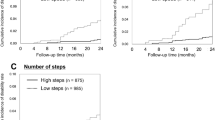Abstract
Background and aims: Triaxial accelerometry may provide a simple measure of physical activity in older people, but the effect of different walking aids and accelerometer placements on measurement is not known. This study aimed to examine the effect of accelerometer placement, use of walking aids, and different types of physical activity on Stay-Healthy RT3 triaxial accelerometer readings in older people. Methods: Twenty subjects aged over 65 years and five younger volunteers were recruited from Medicine for the Elderly services. Subjects performed six minutes each of standardized standing activity, sitting activity, sitting at rest, walking, and stair climbing. Counts generated from RT3 accelerometers worn anteriorly over both hips were recorded in subjects using different walking aids during these standardized activities. Results: There were significant differences between counts generated by the left and right hip positions. The intraclass correlation coefficient of RT3 counts between left and right hip positions was 0.48, 0.39 and 0.99 for sedentary tasks (standing, sitting and rest), stair and walking tasks respectively. Counts ranged between 250–3000 min−1 during the walking task. Counts were proportional to the distance walked. Resting, sitting or standing all generated counts below 250 min−1, but there was no clear demarcation between these activities. The use of different walking aids did not affect the counts generated for any activity. Conclusions: Walking can be distinguished from other activities by upper and lower cutoffs. The RT3 accelerometer should be used on the same side of the body. Different walking aids do not appear to affect RT3 counts in older people.
Similar content being viewed by others
References
Landi F, Cesari M, Onder G, Lattanzio F, Gravina EM, Bernabei R. Physical activity and mortality in frail, community-living elderly patients. J Gerontol A Biol Sci Med Sci 2004; 59: 833–7.
Stessman J, Maaravi Y, Hammerman-Rozenberg R, Cohen A. The effects of physical activity on mortality in the Jerusalem 70-Year-Olds Longitudinal Study. J Am Geriatr Soc 2000; 48: 499–504.
Roberts H, Khee TS, Philip I. Setting priorities for measures of performance for geriatric medical services. Age Ageing 1994; 23: 154–7.
Powell SM, Jones DI, Rowlands AV. Technical variability of the RT3 accelerometer. Med Sci Sports Exerc 2003; 35: 1773–8.
Rowlands AV, Thomas PW, Eston RG, Topping R. Validation of the RT3 triaxial accelerometer for the assessment of physical activity. Med Sci Sports Exerc 2004; 36: 518–24.
Cyarto EV, Myers AM, Tudor-Locke C. Pedometer accuracy in nursing home and community-dwelling older adults. Med Sci Sports Exerc 2004; 36: 205–9.
Kochersberger G, McConnell E, Kuchibhatla MN, Pieper C. The reliability, validity, and stability of a measure of physical activity in the elderly. Arch Phys Med Rehabil 1996; 77: 793–5.
Yngve A, Nilsson A, Sjostrom M, Ekelund U. Effect of monitor placement and of activity setting on the MTI accelerometer output. Med Sci Sports Exerc 2003; 35: 320–6.
Campbell KL, Crocker PR, McKenzie DC. Field evaluation of energy expenditure in women using Tritrac accelerometers. Med Sci Sports Exerc 2002; 34: 1667–74.
Steele BG, Belza B, Cain K, Warms C, Coppersmith J, Howard J. Bodies in motion: monitoring daily activity and exercise with motion sensors in people with chronic pulmonary disease. J Rehabil Res Dev 2003; 40: 45–58.
Author information
Authors and Affiliations
Corresponding author
Additional information
This paper was presented as a poster at the Meeting for Clinical Scientists in training conducted by the Medical Research Society held in London on 23/02/2006.
Rights and permissions
About this article
Cite this article
Sumukadas, D., Laidlaw, S. & Witham, M.D. Using the RT3 accelerometer to measure everyday activity in functionally impaired older people. Aging Clin Exp Res 20, 15–18 (2008). https://doi.org/10.1007/BF03324742
Received:
Accepted:
Published:
Issue Date:
DOI: https://doi.org/10.1007/BF03324742




